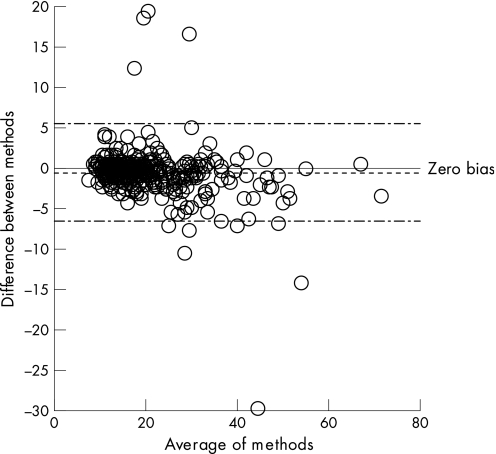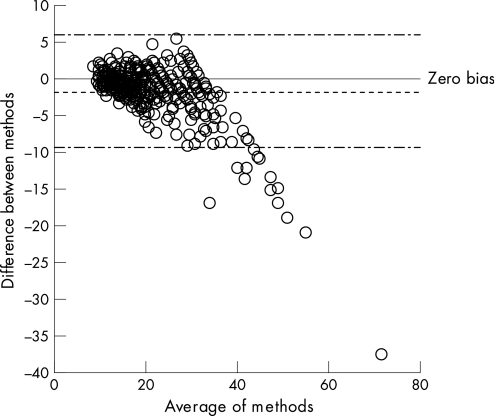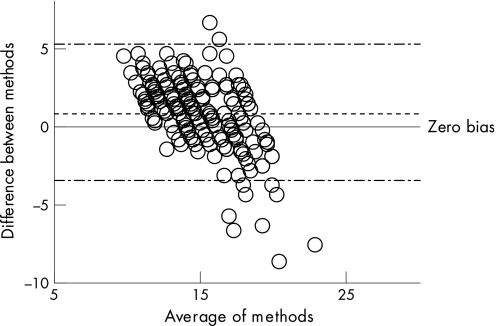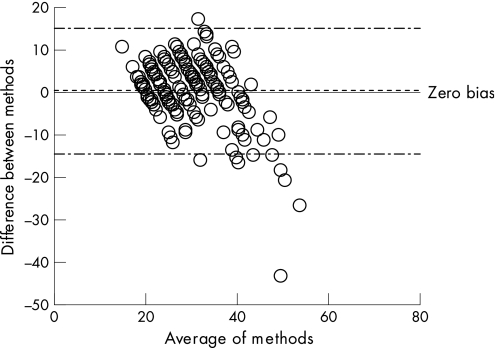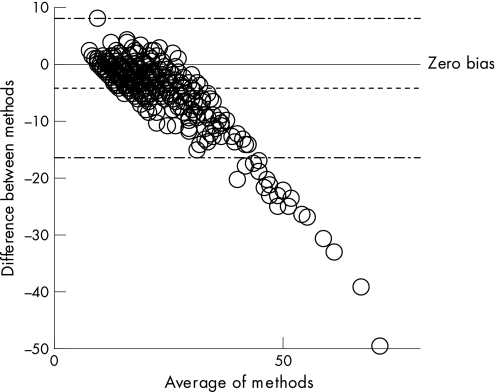Abstract
Objective
To compare the various paediatric weight estimation methods (Advanced Pediatric Life Support, Broselow Tape, Argall, and Best Guess) and parental estimate to measured weight.
Patients and method
A convenience sample of children aged 1–11 years who presented to the emergency department over a 6 month period were eligible for inclusion. Data collected included height, age, ethnicity, parent estimate of weight and measured weight. Body mass index (BMI) was calculated. The outcome of interest was agreement between estimated weight and measured weight for each method. Data were analysed by descriptive statistics and performance of each weight estimation method was compared using mean difference (MD), root mean square error (RMSE) and agreement within 10%.
Results
410 cases were included in this study. The median age was 4 years, there were more boys (54.4%), and the majority of cases were of Caucasian ethnicity (74.9%). The mean BMI of the sample was 17 kg/m2 and mean actual weight was 21.2 kg. Parent estimate was the most accurate method with 78% of parent estimates within 10% of measured weight and the lowest mean difference (−0.6 kg) and RMSE (3.1 kg). The Broselow tape was the most accurate of the other methods, with 61% of estimations within 10% of measured weight.
Conclusion
Parental estimation of weight is more accurate than the other weight estimation methods studied. When this is not available, the Broselow tape is the most accurate alternative method.
Accurate estimation of a child's weight is often necessary in the emergency department (ED) for assessment of clinical status and to enable accurate drug dosage, equipment size and counter shock voltage calculation. Measurement on a set of calibrated scales is ideal but may not always be possible, particularly in the critically ill.
Several methods have been developed which aim to accurately estimate a child's weight. These include the Advanced Pediatric Life Support (APLS) formula,1 the Broselow Tape technique,2 the Argall formula developed in Manchester,3 UK and the Best Guess formulae4 derived in Brisbane, Australia. The age‐based formulae (APLS, Argall, Best Guess) are summarised in table 1. Recently the accuracy of these methods has been challenged.5,6,7,8 A potential alternative is parental estimate of their child's weight. Previous studies have suggested that parents are accurate to within 15% of measured weight on 84% of occasions9 and to within 10% of measured weight on more than 70% of occasions.10,11
Table 1 Summary of weight based formulae.
Our objective was to compare the various weight estimation methods and parental estimate to measured weight in a sample of children treated in an ED.
Patients and methods
This was a prospective, observational study. Melbourne Health Research Directorate Ethics Committee waived the requirement for formal ethics approval as the study was considered a quality assurance/clinical audit/clinical best practice development activity under the National Health and Medical Research Council guidelines (Australia). Consent was not required for study participation.
The study included a convenience sample of paediatric patients who presented to Sunshine Hospital ED between 18 August 2005 and 25 February 2006. Sunshine Hospital is a metropolitan community teaching hospital with a mixed adult and paediatric ED that treats approximately 23 000 children annually. We collected data on clinically stable children, aged between 1–11 years, with a wide variety of health conditions. Children were excluded if their condition was such that urgent care or resuscitation was required. Children were recruited during day and evening shifts on weekdays by the principal investigator (KN), supplemented with some data collected by nurses and medical staff. All staff were trained in use of the measuring devices. Staff were not blinded to the study hypothesis.
Data collected included demographic data such as age, date of presentation, child's height (cm), child's weight (kg), ethnicity and parent estimate of weight which was obtained before measurement of weight to ensure blinding. All children were weighed on a set of standing scales (Seca electronic) or a chair‐like scale (Healthometer electronic), without shoes and heavy layers of clothing. Scales were calibrated by the biomedical department before the start of the study, on a monthly basis after study commencement, and at study conclusion. Children's weights were obtained by indirect weighing for uncooperative children. In these cases, the parent's weight was subtracted from the combined parent and child weight to determine the child's weight, a previously validated and reliable technique.12 Height was measured without shoes using a stadiometer. Children who could not stand and were <1 m tall were measured in the supine position using a Seca 207 infant measurement rod. Body mass index (BMI) was also calculated.
The primary outcome was to compare the various weight estimation methods and parental estimate with measured weight. Data were analysed using Stata13 and Analyse‐It14 data analysis programs. We report descriptive statistics (numbers, mean, standard deviation (SD), range, proportions) for age, gender, height, BMI and weight. Agreement between the various weight estimation methods and parental estimate with measured weight was assessed by calculation of mean bias, SD, root mean square error (RMSE) and modified Bland‐Altman techniques. RMSE combines an assessment of both bias and spread of data. We also report the proportion of cases that were accurate in weight estimation to within 10% of measured weight.
Results
A total of 410 children were enrolled into the study. The mean and median ages of the sample were 4.5 and 4, respectively (range 1–10 years). There were more boys (54%) and the majority of cases were of Caucasian ethnicity (75%). Characteristics of the sample are summarised in table 2.
Table 2 Characteristics of the sample.
| Variable | No. | Statistic | ||
|---|---|---|---|---|
| Age (years) | 410 | Mean | 4.5 | |
| Median | 4 | |||
| SD | 2.8 | |||
| Range | 1–10 | |||
| Gender | 410 | Male | 223 | 54% |
| Female | 187 | 46% | ||
| Ethnicity | 410 | Caucasian | 307 | 75% |
| Asian | 63 | 15% | ||
| African | 14 | 3% | ||
| Other | 11 | 3% | ||
| Indian | 8 | 2% | ||
| Polynesian | 7 | 2% | ||
| Height (cm) | 371* | Mean | 110 | |
| Median | 108 | |||
| SD | 19.6 | |||
| Range | 72–157 | |||
| BMI (kg/m2) | 371* | Mean | 17.1 | |
| Median | 16.6 | |||
| SD | 2.7 | |||
| Range | 11.9–34.7 | |||
| Measured weight (kg) | 410 | Mean | 21.2 | |
| Median | 18.2 | |||
| SD | 10.2 | |||
| Range | 7.5–71.4 | |||
| IQR (25th, 75th) | 13.7, 25.9 | |||
BMI, body mass index ; IQR, interquartile range; SD, standard deviation.
*Missing data.
Where parents were willing to estimate their child's weight (364/410, 89%), this method was the most accurate with 78% of parent estimates within 10% of measured weight and the lowest mean difference (−0.6 kg) and RMSE (3.1 kg). The Broselow tape was the most accurate of the other methods, with 61% of estimations within 10% of measured weight.
A comparison of the methods' performance is shown in table 3 and figs 1–6.
Table 3 Comparison of the weight estimation methods.
| Method | Mean difference (kg) | RMSE | % agreement within 10% of measured weight |
|---|---|---|---|
| Parent estimate | −0.6 | 3.1 | 78 |
| Broselow tape | −1.8 | 4.4 | 61 |
| Best Guess formulae | 0.7 | 5.4 | 42 |
| Argall formula | −1.7 | 5.7 | 37 |
| APLS Formula | −4.2 | 7.5 | 34 |
APLS, Advanced Pediatric Life Support; RMSE, root mean square error.
Figure 1 Modified Bland–Altman bias plot for difference between parent estimate and measured weight.
Figure 2 Modified Bland–Altman bias plot for difference between Broselow tape estimation and actual weight.
Figure 3 Bias plot of agreement between Best Guess method and measured weight for children aged 1–5 years.
Figure 4 Bias plot of agreement between Best Guess method and measured weight for children aged 5–11 years.
Figure 5 Modified Bland–Altman bias plot for difference between Argall formula estimate and actual weight.
Figure 6 Modified Bland–Altman bias plot for difference between Advanced Pediatric Life Support (APLS) formula estimate and actual weight.
Discussion
Accurate estimation of a child's weight is necessary in the ED, particularly to enable accurate drug dosage, equipment size and counter shock voltage calculation in a critically ill child. Several methods have been developed for estimating children's weight, some based on age (for example, Argall, APLS, Best Guess formulae) and some on length/height (for example, Broselow tape). A suggested alternative is asking a parent to estimate the child's weight.
We found that parent estimation, where they were willing to estimate, was the most accurate method for estimation of a child's weight, with 78% accurate to within 10% of measured weight. Three previous studies have reported similar accuracy.9,10,11 It should be noted that 11% of parents declined to provide an estimate. The reasons for this were not explored in the study. It may also depend on which parent is asked as one (more likely the mother) many have more knowledge of their child's weight than the other. Our study design did not allow us to test this.
Our measurements were performed on children in lower Australasian Triage Scale groups indicating non‐critical illness or injury. Parents, who may have been able to provide a weight estimate in less stressful conditions, may not be as capable if their child were critically unwell. In some critically unwell children a parent may not actually be present when resuscitative measures are commenced. Somewhat paradoxically it is precisely this group of children in whom we need to obtain weights via means other than scales.
Of the remaining methods, we found the Broselow tape to be the most accurate, estimating weight to within 10% tolerance in 61% of cases. Other studies report similar predictive accuracy.15,16,17 The Broselow Tape, created in 1986, is somewhat limited as it only applies to children who are between 46–145 cm in length and between 3–34 kg in weight. It also assumes a particular body habitus and may be less accurate with very thin or obese children. It has also been reported that the tape performs less well in some ethnic groups, notably Maori and Pacific island peoples.5 Of the age‐based formulae, the Best Guess method was most accurate with both the Argall and APLS formulae performing poorly. The APLS formula has also been shown to perform poorly by other studies.6,7,17 The Argall formula had not previously been tested.
While parent estimate maintained its accuracy across the weight range, the Argall and APLS methods' performance dropped off sharply with increasing weight, particularly above 40 kg. The Broselow tape also performed less well at higher weights which may be due to body habitus and ethnicity as discussed previously.5
This study has some limitations that must be considered when interpreting the results. This was a convenience sample and excluded seriously ill children, and may therefore have been biased. We did not collect data on socioeconomic status or parent educational level. The sample is derived from a single, multi‐ethnic Australian study site and may not be generalisable to other settings. Most data were collected when the principal researcher was available to do so. This limited participant numbers and potentially introduced bias. More representative sampling may have been achieved with a larger sample size or a multicentre design. We did not have sufficient sample size to validly compare ethnic or BMI subgroups.
Based on the available data, it would seem appropriate to use parent estimate of their child's weight, if they are prepared to give it, as the first option for weight estimation in a sick child who cannot be weighed. Where that is not available and the child fits within the Broselow tape's limits, its use would be the most appropriate second choice. If an aged‐based formula is the only option the Best Guess formulae are preferred.
Abbreviations
APLS - Advanced Pediatric Life Support
BMI - body mass index
ED - emergency department
RMSE - root mean square error
SD - standard deviation
Footnotes
Competing interests: None declared
References
- 1.Advanced Life Support Group Advanced paediatric life support: the practical approach, 4th ed. Oxford: BMJ Books/Blackwells, 2005
- 2.DeBoer S, Seaver M, Broselow J. Color coding to reduce errors. Am J Nurs 200510568–71. [DOI] [PubMed] [Google Scholar]
- 3.Argall J A W, Wright N, Mackway‐Jones K.et al A comparison of two commonly used methods of weight estimation. Arch Dis Child 200388789–790. [DOI] [PMC free article] [PubMed] [Google Scholar]
- 4.Tinning K K, Acworth J P.Make your best guess: an updated method for paediatric weight estimation. Proceedings of Annual Scientific Meeting. Australasian College for Emergency Medicine 2006
- 5.Theron L, Adams A, Jansen K.et al Emergency weight estimation in Pacific Island and Maori children who are large‐for‐age. Emerg Med Australas 200517238–243. [DOI] [PubMed] [Google Scholar]
- 6.Black K, Barnett P, Wolfe R.et al Are methods used to estimate weight in children accurate? Emerg Med (Fremantle) 200214160–165. [DOI] [PubMed] [Google Scholar]
- 7.Carroll W, Alexander J. Towards better weight estimation in the seriously ill child – a comparison of methods. Arch Dis Child 200184(Suppl I)A12 [Google Scholar]
- 8.Nguyen K, Krieser D, Kerr D.et al Failed validation of the Argall weight formula for estimating children's weight in an Australian ED. Acad Emerg Med 200714486–488. [DOI] [PubMed] [Google Scholar]
- 9.Harris M, Patterson J, Morse J. Doctors, nurses and parents are equally poor at estimating pediatric weights. Pediatr Emerg Care 19991517–18. [DOI] [PubMed] [Google Scholar]
- 10.Leffler S, Hayes M. Analysis of parental estimates of children's weights in the ED. Ann Emerg Med 199730167–170. [DOI] [PubMed] [Google Scholar]
- 11.Goldman R D, Buskin S, Augarten A. Parental estimates of their child's weight: accurate for resuscitation drug doses. Pediatr Emerg Care 19991519–21. [DOI] [PubMed] [Google Scholar]
- 12.Vessey J, Stueve D. A comparison of two techniques for weighing young children. Paediatr Nurs 199622327–330. [PubMed] [Google Scholar]
- 13.Stata Corporation Stata statistical software: release 8.2. College Station, Texas: Stata Corporation, 2003
- 14.Anon Analyse‐It for Microsoft Excel, Leeds, UK. http://www.analyse‐it.com/ [computer program]
- 15.Hofer C, Ganter M, Tucci M.et al How reliable is length‐based determination of body weight and tracheal tube size the paediatric age group? The Broselow tape reconsidered. Br J Anaes 200288283–285. [DOI] [PubMed] [Google Scholar]
- 16.Lubitz D S, Seidel J S, Chameides L.et al A rapid method for estimating weight and resuscitation drug dosages from length in pediatric age group. Ann Emerg Med 198817576–581. [DOI] [PubMed] [Google Scholar]
- 17.Dearlove C B, Dearlove O. Visual estimation of children's weights. Anaesthesia 1999541228–1229. [DOI] [PubMed] [Google Scholar]



